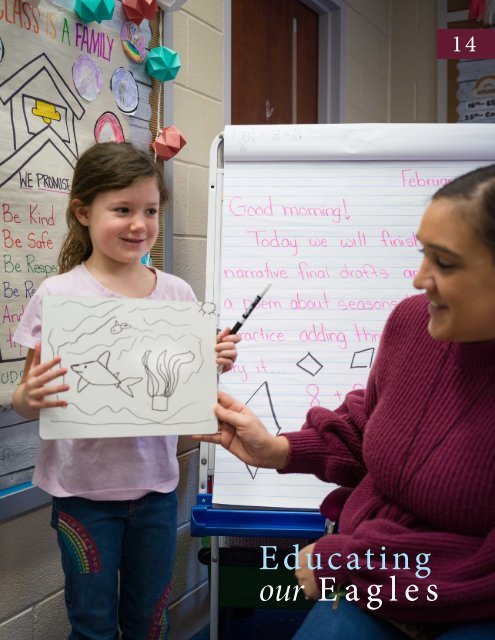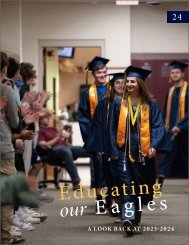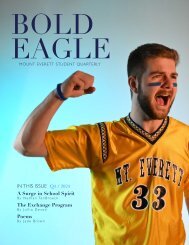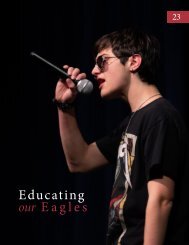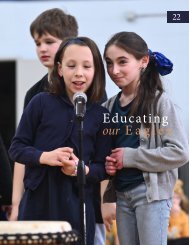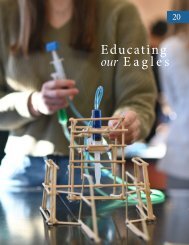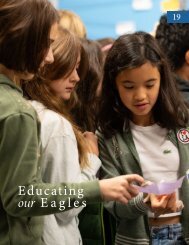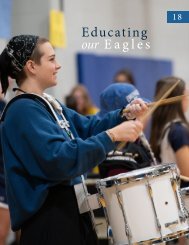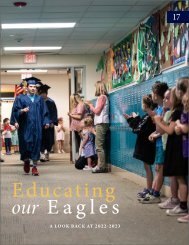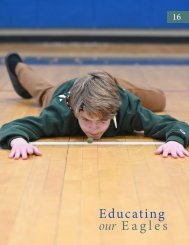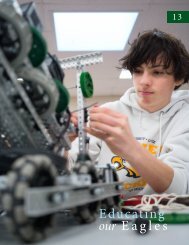You also want an ePaper? Increase the reach of your titles
YUMPU automatically turns print PDFs into web optimized ePapers that Google loves.
<strong>Educating</strong><br />
our <strong>Eagles</strong><br />
<strong>14</strong>
CONTENTS<br />
4<br />
Introduction - Curriculum Director, Julie Dolan<br />
6<br />
First Grade - 100 Days of School – Christina Carlson, Ashley Lotz<br />
8<br />
High School - Drawing - Graphic Novel – Kevin Wolgemuth<br />
10<br />
Second Grade - 100th Day STEM Challenge – Elizabeth Trapani<br />
12<br />
High School - Learning Spanish With Storytelling – Angela Spitia<br />
15<br />
Middle School - Minimalism and Abstraction – Kari Giordano<br />
Cover: First grade students learn about shapes.<br />
Right: Elementary students work on a Culture project during<br />
Spanish Class.<br />
EDUCATING OUR EAGLES<br />
2
EDUCATING OUR EAGLES<br />
3
INTRODUCTION<br />
From SBRSD’s Director of Curriculum<br />
and Instruction, Julie Dolan<br />
We are excited to share with you the progress made in our<br />
first year as a designated district-wide Early College. It is<br />
a unique and special opportunity, in collaboration with<br />
Bard College at Simon’s Rock, to expose our students<br />
to college-level courses in the safe and supportive<br />
environment of SBRSD.<br />
As we began the second semester of our first year, we<br />
celebrated the success of our students and took some<br />
time to recognize all those that took on the challenge of<br />
EDUCATING OUR EAGLES<br />
4
participating in an Early College course. About 90% of<br />
our seniors now know what it is like to take a collegecredit<br />
course and our sophomore class will be the first<br />
class to have the opportunity to earn up to 30 college<br />
credits by the time they graduate from high school at<br />
no cost to them.<br />
<strong>Our</strong> goal is to have as many of our teachers as possible<br />
complete the Early College Instructor Certification.<br />
This will give us flexibility and increase the variety of<br />
courses offered. Congratulations to Mr. Wolgemuth for<br />
being our first teacher to complete this program and be<br />
teaching college credit classes.<br />
This is an exciting program that will continue to grow.<br />
If you have any questions about SBRSD being a wall-towall<br />
Early College, you can contact me at<br />
jdolan@sbrsd.org.<br />
5
ELEMENTARY SCHOOL:<br />
100th Day Celebration!<br />
First Grade students in Ms. Carlson and Ms. Lotz’s classes celebrated 100 days of<br />
school this month! The students practiced counting, grouping, and organzing by<br />
moving through nine different stations all teaching about the number 100.<br />
As a result of instruction, students will be able to:<br />
• count to 100.<br />
• groups items to 100.<br />
Observations:<br />
The students were excited and engaged to complete their 9 stations on their golden ticket<br />
to celebrate the 100th day of school.<br />
MA Standards:<br />
1.NBT<br />
EDUCATING OUR EAGLES<br />
6
EDUCATING OUR EAGLES<br />
7
MIDDLE SCHOOL:<br />
Drawing - Graphic Novel<br />
This spring semester, “Graphic Novel and Visual Narrative” offers high school<br />
students the opportunity to earn college credit while exploring published works<br />
... and creating original work of their own! Weekly drawing activities include<br />
collaborative panel progressions, character development and bio sheets, timed<br />
comic strips, world design and classic graphic novel imitations.<br />
As a result of instruction, students will be able to:<br />
• apply theories and concepts from Scott McCloud's “Understanding Comics” (1993)<br />
in the appreciation, analysis, imitation and creation of graphic novels and visual<br />
narratives.<br />
Observations:<br />
Give students a pencil, a blank sheet of paper and time to think, and stand back!<br />
MA Standards:<br />
Multiple comparative reading standards<br />
EDUCATING OUR EAGLES<br />
8
EDUCATING OUR EAGLES<br />
9
ELEMENTARY SCHOOL:<br />
100th Day Stem Challenge<br />
Continuing with the 100th day of school celebration, Second Grade students At NMC were<br />
provided with building materials and were asked to construct several different designs<br />
using 100 pieces for each of their creations. Materials students used included milk caps,<br />
legos, dominoes, linking cubes, pattern blocks, and popsicle sticks.<br />
As a result of instruction, students will be able to:<br />
• work collaboratively and creatively to create an original design.<br />
• use problem solving skills by listening to each other's ideas and thinking critically.<br />
Observations:<br />
Students were randomly placed in teams of two and they worked together. The teams were focused<br />
and motivated to create an original design with each set of materials.<br />
MA Standards:<br />
K-2-ETS1-3 Engineering Design<br />
EDUCATING OUR EAGLES<br />
10
EDUCATING OUR EAGLES<br />
11
HIGH SCHOOL:<br />
Learning Spanish With Stories<br />
Throughout each grade, and part of our curriculum, we use stories to learn Spanish. In 9th grade<br />
, we started reading a book called “Peter va a Colombia” (Peter goes to Colombia). Each grade<br />
learns about a different country and culture of the Latin American world. The students learn<br />
Spanish in a communicative way by focusing on the events of the story, instead of the grammar<br />
of the language. This focus helps the students communicate in the language from the start, as the words<br />
appear in context. We study new vocabulary before reading using Quizlet and printouts, so that the<br />
students understand the stories better. After studying the vocabulary, we read aloud, sometimes in groups<br />
or by themselves, and once we finish reading the chapter, the students answer comprehension questions<br />
using the target language. We also use Kahoot to answer comprehension questions about the reading.<br />
Finally, we summarize each chapter. We also make drawings to practice listening comprehension and to<br />
retell the stories.<br />
As a result of instruction, students will be able to:<br />
• improve and learn Spanish vocabulary.<br />
• improve reading comprehension.<br />
• learn about customs and traditions in Colombian culture.<br />
• compare and contrast Colombian culture with their own.<br />
• make connections between the influences of different genres of music.<br />
Observations:<br />
The students are increasing their Spanish vocabulary. They understand words in context and they can respond<br />
to comprehension questions in Spanish. The repetition used in storytelling helps them remember and<br />
memorize full sentences and vocabulary.<br />
MA Standards:<br />
Interpretive communication: In straightforward texts and conversations on very familiar, everyday topics,<br />
relying upon practiced or memorized words or phrases supported by visuals and gestures, students:<br />
Identify words, phrases, and basic information. (NL.Com.Ipv.1.b)<br />
Interpersonal Communication - In straightforward conversations on very familiar, everyday topics in highly<br />
predictable, common daily settings, using practiced or memorized words or phrases and with the help of<br />
visuals and gestures, students:<br />
Respond to culturally diverse interlocutors, products, practices, and ideas by expressing curiosity and<br />
empathy. (NL.Com.Ipl.2.a)<br />
Cultures - In straightforward interactions in highly predictable common daily settings, using the target<br />
language exclusively (or almost exclusively), with appropriate linguistic scaffolding, students minimally but<br />
consistently:<br />
Identify typical products and practices to help understand perspectives within the diverse cultures of the<br />
target-language communities. (NL.LC.Cul.5.a)
EDUCATING OUR EAGLES<br />
13
MIDDLE SCHOOL:<br />
Minimalism and Abstraction<br />
Eighth grade art students studied the work of American architect and designer, Frank<br />
Lloyd Wright. Students looked at examples of his ‘organic style’ architecture and his<br />
later work with stained glass. The class was guided through exercises creating work<br />
using the Prairie Style and other methods of abstraction. Through color theory study<br />
and exploration of Abstract Art and Minimalism, students ultimately used black<br />
construction paper, X-acto knives, colored tissue paper and cellophane to create faux<br />
stained glass windows inspired by a landscape of their choosing.<br />
As a result of instruction, students will be able to:<br />
• recognize and analyze the style of Frank Lloyd Wright.<br />
• recognize and analyze Minimalism and abstraction in art and design.<br />
• carefully use an X-acto knife to cut intricate designs in paper.<br />
• practice color theory by mixing cellophane colors together.<br />
• practice craftsmanship, design, and presentation skills.<br />
Observations:<br />
The class expressed varying opinions about Frank Lloyd Wright's work and Abstract Art in general.<br />
Students shared their ideas about what they consider to be "good" art and what they do not. The class<br />
had a construction discussion about an artist's process and what symbols might be visible in Abstract<br />
Art and Minimalism. Students struggled with the intricate cutting and gluing and there were some<br />
do-over moments. It was a good reminder to stay focused and limit distractions. The faux stained glass<br />
pieces came together in a really neat way and it was fun to see all of the different landscapes. Students<br />
created pieces ranging from Greek Islands to Football stadiums. It is always fun to see the wide variety<br />
of ideas our students represent.<br />
MA Standards:<br />
Generate and conceptualize artistic ideas and work. Generate artistic ideas that demonstrate differences<br />
in composition principles (e.g., balance, proportion, emphasis) and push the boundaries of what<br />
materials can do. (7-8.V.Cr.01)<br />
Perceive and analyze artistic work. Analyze elements of a work that are indicative of the historical or<br />
cultural context in which it was created. (7-8.V.R.07)<br />
Interpret intent and meaning in artistic work. Explain how an artistic work was influenced by the<br />
culture or historical context in which it was created. (7-8.V.R.08)
EDUCATING OUR EAGLES<br />
15
EDUCATING OUR EAGLES<br />
16


